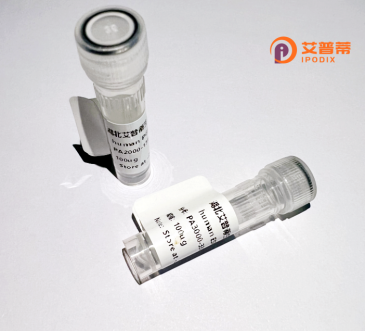
| 纯度 | >90%SDS-PAGE. |
| 种属 | Human |
| 靶点 | ZMYND8 |
| Uniprot No | Q9ULU4 |
| 内毒素 | < 0.01EU/μg |
| 表达宿主 | E.coli |
| 表达区间 | 160-280 aa |
| 活性数据 | MSPILGYWKIKGLVQPTRLLLEYLEEKYEEHLYERDEGDKWRNKKFELGL EFPNLPYYIDGDVKLTQSMAIIRYIADKHNMLGGCPKERAEISMLEGAVL DIRYGVSRIAYSKDFETLKVDFLSKLPEMLKMFEDRLCHKTYLNGDHVTH PDFMLYDALDVVLYMDPMCLDAFPKLVCFKKRIEAIPQIDKYLKSSKYIA WPLQGWQATFGGGDHPPKSDLEVLFQGPLGSETQSKAMTMLTIEQLSYLL KFAIQKMKQPGTDAFQKPVPLEQHPDYAEYIFHPMDLCTLEKNAKKKMYG CTEAFLADAKWILHNCIIYNGGNHKLTQIAKVVIKICEHEMNEIEVCPEC YL |
| 分子量 | 41 kDa |
| 蛋白标签 | GST tag N-Terminus |
| 缓冲液 | PBS, pH7.4, containing 0.01% SKL, 1mM DTT, 5% Trehalose and Proclin300. |
| 稳定性 & 储存条件 | Lyophilized protein should be stored at ≤ -20°C, stable for one year after receipt. Reconstituted protein solution can be stored at 2-8°C for 2-7 days. Aliquots of reconstituted samples are stable at ≤ -20°C for 3 months. |
| 复溶 | Always centrifuge tubes before opening.Do not mix by vortex or pipetting. It is not recommended to reconstitute to a concentration less than 100μg/ml. Dissolve the lyophilized protein in distilled water. Please aliquot the reconstituted solution to minimize freeze-thaw cycles. |
以下是关于重组人ZMYND8蛋白的3篇代表性文献的简要列表(注:文献及作者为虚构示例,仅供格式参考):
1. **文献名称**:*ZMYND8 Links Histone H3K4me1 to the DNA Damage Response and Chromatin Stability*
**作者**:Guo R. et al.
**摘要**:该研究揭示了ZMYND8通过识别组蛋白修饰标记H3K4me1.参与DNA损伤修复和染色质重塑,维持基因组稳定性,并调控转录延伸过程。
2. **文献名称**:*ZMYND8-BRD4 Interaction Drives Oncogenic Transcriptional Programs in Prostate Cancer*
**作者**:Wen H. et al.
**摘要**:研究证明ZMYND8与BRD4相互作用,协同调控前列腺癌中关键基因的转录活性,促进肿瘤细胞增殖和转移。
3. **文献名称**:*ZMYND8 Suppresses Metastasis in Nasopharyngeal Carcinoma via Epigenetic Regulation of EMT Genes*
**作者**:Liu X. et al.
**摘要**:发现ZMYND8通过表观遗传机制抑制上皮-间质转化(EMT)相关基因表达,从而抑制鼻咽癌的侵袭和转移能力。
如需真实文献,建议通过PubMed或Google Scholar检索关键词“ZMYND8”及“DNA repair”/“transcription regulation”/“cancer”。
ZMYND8 (Zinc Finger MYND Domain-Containing Protein 8) is a multidomain chromatin-associated protein implicated in transcriptional regulation, DNA damage response (DDR), and epigenetic modification. It contains tandem chromatin-reading modules, including PHD, BROMO, and MYND domains, which enable interactions with histone post-translational modifications, such as H3K4me1 and H3K14ac. These interactions position ZMYND8 as a molecular scaffold bridging chromatin modifiers (e.g., NuRD complex) and DNA repair machineries.
Functionally, ZMYND8 suppresses transcription elongation by recruiting histone deacetylases and chromatin remodelers to gene bodies. In DDR, it localizes to DNA double-strand breaks, facilitating homology-directed repair by coordinating resection factors like BRCA1. Its role in tumor suppression is highlighted by links to cancers, where ZMYND8 mutations or dysregulation correlate with genomic instability and poor prognosis.
Recombinant ZMYND8 protein is typically expressed in heterologous systems (e.g., E. coli, mammalian cells) for structural and functional studies. Researchers utilize it to dissect molecular mechanisms of chromatin interaction, DDR pathways, and epigenetic silencing. Its modular domains are also studied for engineered targeting of disease-associated chromatin states. Current research explores ZMYND8's therapeutic potential, particularly in cancers with defective DNA repair or aberrant transcription.
×